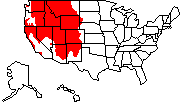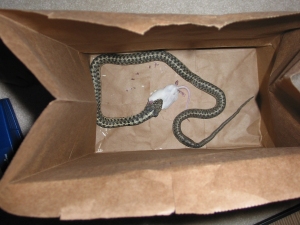|
Wandering Garter Snake
"Nibbles"
|
- Order: Squamata (scaled reptiles)
- Suborder: Serpentes (snakes)
- Family: Colubridae ("typical" snakes)
- Subfamily: Natricinae (garter and water snakes)
- Genus: Thamnophis (garter and ribbon
snakes)
|
|
Scientific Name: Thamnophis
elegans vagrans Baird and Girard, 1853 |
| Habitat: A wide range
of habitats found throughout the western United States, but
typically near water. This specimen was found near a stream
near Colorado Springs, Colorado. |
Thamnos="bush," ophis="snake,"
elegans="elegant," vagrans="wandering"
|
| Length: This specimen
is around 30 inches long; maximum total length reported to be 42
inches. |
|
| Food: This specimen
has eaten goldfish, minnows, rosy reds and tuffies (both feeder
fish), mice ranging in size from pinkies through adult,
nightcrawlers, toads, and even bits of hard-boiled egg white
(scented with earthworm). |
 |
|
My friend found this snake in September
1995. He appears to have been hit by a lawnmower, or met
with a similar fate, as his back looks like it's been broken (and
subsequently healed) and he has other cuts and scale damage on his
tail. |
 |
| I named this snake
"Nibbles," after the obscure
game written in Microsoft QBasic
and included in early versions of Windows (this game was a LOT
like the "Snake"
game found on some
Nokia cell phones). He's an ornery little snake, mostly
because I don't handle him--and with good reason: some
people have been known to develop allergic reactions to the saliva
of wandering garter snakes (scroll down for references). I
only take him out of his cage to feed him, and I use a small snake
hook when doing so. |
|
| When feeding, I place Nibbles in
a standard paper grocery sack and weigh him on a digital postal
scale both before and after feeding, to get a feel for how much
he's eating. He generally weighs around 4 ounces.
I used to keep him active year-round, but for the last couple
of years I've "brumated" him over the winter months by
placing his cage in my garage.
|
 |
| References to Garter Snake
Envenomation:
Ann Emerg Med. 1994 May;23(5):1119-22. "Human
envenomation from a wandering garter snake."
Gomez HF, Davis M, Phillips S, McKinney P, Brent J.
Rocky Mountain Poison and Drug Center, Denver General Hospital,
University of Colorado Health Sciences Center.
Garter snake bites are generally innocuous to human beings. We
report a case of human envenomation from the Wandering Garter
snake (Thamnophis elegans vagrans). The patient, who was
bitten on his right third fingertip, rapidly developed local
edema, ecchymosis, and hemorrhagic vesicles. Systemic signs and
symptoms did not develop. The clinical picture was similar to that
in three previous patients with Thamnophis envenomation in
that clinical signs followed a prolonged bite. Thamnophis
species have Duvernoy's glands, which may be analogous to venom
glands in Crotalidae (pit viper) species. The progressive local
effects produced by secretions of these glands may be confused
with early Crotalidae envenomation.
Clin Toxicol. 1981 May;18(5):573-9. Envenomation
following the bite of a wandering garter snake (Thamnophis
elegans vagrans). Vest DK.
Following a prolonged bite by a large specimen of the wandering
garter snake (Thamnophis elegans vagrans), symptoms of
envenomation rapidly developed. Swelling, edema, pain, and
localized hemorrhaging occurred but without the subsequent onset
of systemic manifestations. The bite recipient was carefully
examined and the evolution of poisoning monitored. Depending upon
duration of the bite and inclination of the snake, members of this
species are capable of occasionally causing mild envenomation in
humans, inducing localized poisoning not unlike
that seen following bites by small Crotalidae (pit vipers).
Toxicon. 1985;23(4):719-21. Human envenomation from
the bite of the eastern garter snake, Thamnophis s. sirtalis
(Serpentes: Colubridae). Hayes WK, Hayes FE.
A 13-yr-old victim of a prolonged eastern garter snake (Thamnophis
s. sirtalis) bite was hospitalized following development of
coolness, edema and ecchymosis of the bitten hand. Although
lymphatic involvement was noted, vital signs and laboratory tests
were normal and rapid recovery followed. Subsequent asymptomatic Thamnophis
bites of the subject indicate that these clinical changes were not
allergic. This case from Delaware suggests that widespread
toxicity within the genus is likely.
|
|
|
Up |
|
|